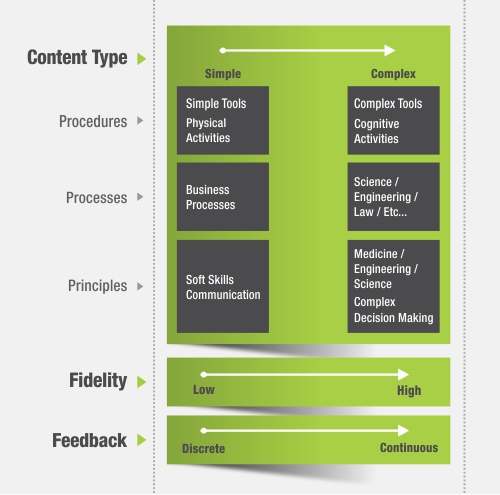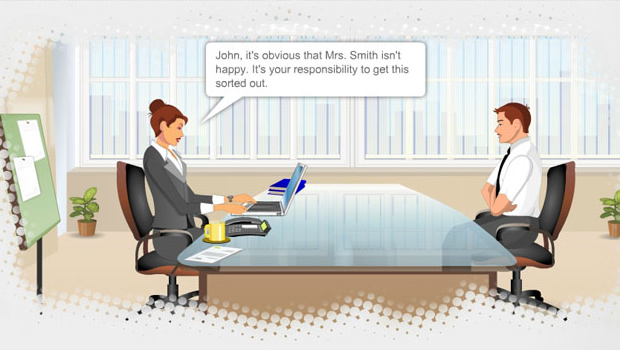Scenarios have been used as learning tools throughout history. Scenario interaction and feedback has been human mediated over most of this history of use. In the last few years technology assisted mediation has reached a stage where scenarios built using such technologies are now an integral part of eLearning.
Evans and Taylor (Evans & Taylor, 2005) define scenarios “as stories focused on a user or group of users, which would provide information on the nature of the users, the goals they want to achieve and the context in which the activities will take place. They are written in ordinary language, and are therefore understandable to various stakeholders, including users. They may also contain different degrees of detail.”
J. Carroll (Carroll, 1999) attributes five characteristic elements to e-Learning scenarios: they include or presuppose a setting, they include agents or actors and each agent or actor has typically goals or objectives; every scenario has at least one agent and at least one goal. Finally all scenarios include sequences of actions and events, things that happen and change the scenario setting.
In our opinion, it is best to use interactive scenarios to support active learning strategies such as problem-based or case-based learning. It normally requires a learner to navigate a storyline/narrative across a temporal space (time), leading to an exploration of the aspects of and eventually resolution of the problem (posed in the scenario). Navigation of a scenario leading ‘decision’ points of the scenario requires the application of knowledge, critical thinking and to an extent, problem solving.
For workplace learning, scenarios can be used for developing skills that require decision-making based on a ‘set of principles’. They can be used for soft skills such as selling, communication, etc. Oftentimes, the word ‘scenario’ is incorrectly associated with EAT (Enterprise Application Training) simulations and refers to the setting of the scene that requires a particular procedure (being simulated). It can help to think of scenarios as a type of social simulations (think of the game ‘The Sims’).
Typically outcomes that involve decision making based on a ‘principle set’ are best served with scenarios as an instructional strategy. We often recommend the use of scenarios for technical/professional knowledge and skills as well. If the learning outcomes you require are predominantly at a recall/comprehension level, scenarios are not the way to go; you’d be better off using a series of discrete displays and associated practice examples.
One aspect of simulations that applies equally well to scenarios is ‘fidelity’. How real does a scenario/simulation need to be to achieve the required learning outcomes? This is especially true of scenarios that involve soft/communication skills; the use of video (high fidelity) is more effective than the use of image/voice-over.
The cost of design and development of scenarios varies and depends on various factors (not limited to):
1. Learning outcome
2. Level of detail and branching
3. Decision point and feedback strategy
4. Use of media
There are definitely some positive implications for use of scenarios:
- Allows designers to Influence outcomes in the affective domain (Bloom)
- Encourages critical thinking and problem solving
- Allow risk-free exploration of outcomes (similar to simulations)
- Requires leverage of learned knowledge/skills to achieve favorable outcomes
On the other hand, there are some clear drawbacks:
- Text/Audio/Images used for representation result in a substantial drop in fidelity. If you want decent fidelity, try to use video. (especially for soft/communication skill courses)
- How the narrative/event/situation is written and elaborated is important, too little detail results in it being interpreted as superficial, too much detail will result in difficulties understanding and may cause learner to be diverted from key learning/observations.
- Scenarios are developed best using an iterative approach and this involves significant time from both designers and SMEs.

Try answering these questions to determine if SBL is the right option? (Clark, 2009)
- Are the outcomes based on skills development or problem-solving?
- Is it difficult or unsafe to provide real-world experience of the skills?
- Do your students already have some relevant knowledge to aid decision-making?
- Do you have time and resources to design, develop, and test an SBL approach?
- Will the content and skills remain relevant for long enough to justify the development of SBL?
DOs and DON’Ts
- Ensure there are direct and real consequences for every action the learner takes.
- Ensure learners know why they failed. Feedback should be more than ‘Correct/Incorrect, please try again’. This may require writing detailed individual options, each of which is a plausible response to the question posed or decision required.
- When designing scenario-based-learning, it helps to keep in mind that feedback can be both discrete and continuous. Typically designers are inclined to use discrete feedback in scenarios, but could also consider the use of continuous feedback elements such as scores or levels (typically game-based learning elements used in SBL to engage and motivate better).
- It follows that the designer would write customized remedial feedback for each option. Do not under-estimate the learner’s intelligence. Don’t add decision points simply to allow learner interaction with the scenario. Instead, the decision points must make them think carefully about the options available before choosing one. This requires each option to be plausible and relevant.
- Allow the learner to go back into time as and when they choose (not only when presenting the scenario, but also at any other point in the learning experience). One of the critical skills we are trying to develop is ‘discrimination’, so in a sense, they should be able to stop going down a particular branch of the decision tree the moment they realize they are going wrong. This mimics real life closely, you’d stop whatever you were doing the moment you realize you are going wrong, not necessarily when told you are wrong.
- Think about balance – visualize your scenario as a tree, it should be fairly symmetrical around the central trunk, and the branches should appear similar to each other. It is alright to have a few dead ends, but most paths through the branches should lead to an outcome of some sort.
- In a way, a scenario is modeled based on a ‘theme’ or a ‘world’, as a result thematic consistency matters. Actions/decisions should ideally reflect the context of the world they are made in. It would be incongruous to have actions in the scenario not reflect the world in which they are made in.



















